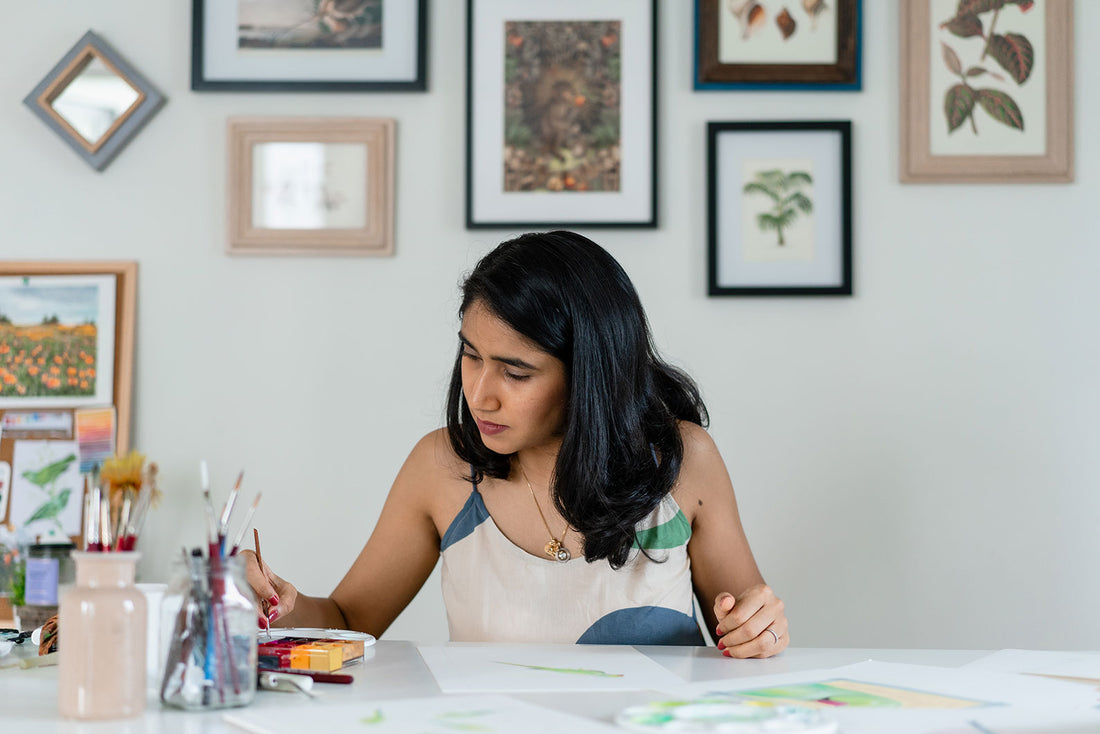If you’re someone struggling to find your art style, then you’re in the right place!
In this article, I’ve briefly gone over 6 things that helped me find my art style and discover the path I’m now happily strolling down. If you want a more detailed version then check out the video but if you’re in for the quick fix, then read along!
If you are feeling like your artworks are all over the place, you are not able to tie them together, or find a pattern or direction in them, if you’re not sure what’s your medium or style or if the medium you are working with is your medium, etc. etc., then know this. EVERY artist has gone through this and sorry to be the one to bust your bubble, but this is kind of an ongoing thing. I’ll tell you why in a moment.
I decided to start my professional journey as an artist a couple of years ago and when I did, I was interested in many things: subjects, styles, mediums, and I had no idea how to tie them together and boy, how badly did I want to tie them together.
From then to now, when I’m all set to launch my first art collection, I’ve learnt a few key things that helped me find my art style and direction that I am excited to share with you hoping that it helps you in your art journey.
So here goes:
-
Chase your curiosity: It's very important not to box yourself in, especially when you are starting out. The only way you are going to find your style is by trying to paint in every possible style! As you keep trying new styles and techniques, you’ll start to recognise the styles, techniques, colours, and tools that you are comfortable with and allow you to express yourself most. Take your time and let this happen organically!
-
Dance with your moods: Your moods and feelings have a profound impact on your creativity. This might not come easy but try to become aware of the way you are feeling every time you paint.
Try to recognise how you are feeling when you want to paint when you are painting, and after you complete a piece. This will help you recognise patterns in your style from the colours you choose to your brush strokes.
-
Never stop learning: In art, there is no arriving. It is important that you understand and accept that your art and art style is constantly evolving and the only way to feed your creativity and inspiration is by being open to learning constantly.
Watch the work of other artists, observe their thinking, how their art styles are evolving, their colour choices, and their brush styles. Try to replicate them, notice how your own style evolves as you try new styles and techniques.
-
Practice daily: This is something that helped me immensely. When you paint every day, very soon you’ll have a good collection of work to put side by side and look at visually. This will help you recognise patterns in your art style, themes that you’ve gravitated towards, subjects that you’ve most enjoyed painting, techniques that helped you express yourself best, etc.
I did this by challenging myself to ‘100 days of sketchbooking’. Of course, I missed a few days but the trick was to not let that get me down and just get back to painting the next day. I also do my morning pages (an idea from The Artist’s Way), which is basically a brain dump first thing every morning. It may be where I flesh out ideas for art, or where I just rant about how I’m feeling. Either way, it helps me overcome creative blocks and start my day with a clear mind.
-
Trust and lean into YOUR intuition: This might be both vague and easier said than done, especially if you’re just starting out. But with art, like any creative endeavour, creating what you truly love and enjoy is the only way to sustain.
Irrespective of current demand, opinions, trends etc, trust and listen to your gut, feelings, and emotions, and recognise what gets you excited and gives you joy because in the long run, that will bring you more value than the art you create to satisfy the current market demands.
-
Accept: This is a challenging one but it is important to accept that your art style is constantly evolving. 2 years down the line, if you look back, you might not even like what you had painted but it is important to recognise that every piece of art you have created has played a role in who you are as an artist today and every piece of art you are creating now will play a role in who you are as an artist in the future.
So when you look back to analyse your artwork for patterns and inspirations, be kind to yourself and be open to experimenting and constantly evolving. This will help you get better while also appreciating your work. After all, you have to be your biggest fan!
Of course, I did not discover these techniques, or hacks as I’d like to call them, all by myself! It came from watching and learning from the artists who inspire me and of course tonnes of online resources and books! So, I would also like to leave you with 3 books that helped me in my journey to finding my art style and I highly recommend every budding artist:
If you’re a budding artist looking for tips, tricks, hacks, and inspiration or a fellow creative person looking for support, join my little community of creative minds and let’s start a conversation!
Watch the full video :

